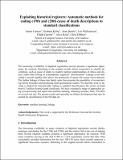Files in this item
Exploiting historical registers: Automatic methods for coding c19th and c20th cause of death descriptions to standard classifications
Item metadata
| dc.contributor.author | Carson, Jamie Kirk | |
| dc.contributor.author | Kirby, Graham Njal Cameron | |
| dc.contributor.author | Dearle, Alan | |
| dc.contributor.author | Williamson, Lee | |
| dc.contributor.author | Garrett, Eilidh | |
| dc.contributor.author | Reid, Alice | |
| dc.contributor.author | Dibben, Christopher John Lloyd | |
| dc.date.accessioned | 2014-09-12T09:01:05Z | |
| dc.date.available | 2014-09-12T09:01:05Z | |
| dc.date.issued | 2013-03-05 | |
| dc.identifier | 44100399 | |
| dc.identifier | 1314709c-8a20-4431-92c5-576dca1a9b56 | |
| dc.identifier.citation | Carson , J K , Kirby , G N C , Dearle , A , Williamson , L , Garrett , E , Reid , A & Dibben , C J L 2013 , Exploiting historical registers: Automatic methods for coding c19th and c20th cause of death descriptions to standard classifications . in New Techniques and Technologies for Statistics . Eurostat , http://www.cros-portal.eu/content/ntts-2013-proceedings , pp. 598-607 , New Techniques and Technologies for Statistics (NTTS 2013) , Brussels , Belgium , 5/03/13 . https://doi.org/10.2901/Eurostat.C2013.001 | en |
| dc.identifier.citation | conference | en |
| dc.identifier.other | ORCID: /0000-0002-4422-0190/work/28429094 | |
| dc.identifier.uri | https://hdl.handle.net/10023/5409 | |
| dc.description.abstract | The increasing availability of digitised registration records presents a significant opportunity for research. Returning to the original records allows researchers to classify descriptions, such as cause of death, to modern medical understandings of illness and disease, rather than relying on contemporary registrars’ classifications. Linkage of an individual’s records together also allows the production of sparse life-course micro-datasets. The further linkage of these into family units then presents the possibility of reconstructing family structures and producing multi-generational studies. We describe work to develop a method for automatically coding to standard classifications the causes of death from 8.3 million Scottish death certificates. We have evaluated a range of approaches using text processing and supervised machine learning, obtaining accuracy from 72%-96% on several test sets. We present results and speculate on further development that may be needed for classification of the full data set. | |
| dc.format.extent | 10 | |
| dc.format.extent | 179659 | |
| dc.language.iso | eng | |
| dc.publisher | Eurostat | |
| dc.relation.ispartof | New Techniques and Technologies for Statistics | en |
| dc.subject | QA75 Electronic computers. Computer science | en |
| dc.subject | HA Statistics | en |
| dc.subject.lcc | QA75 | en |
| dc.subject.lcc | HA | en |
| dc.title | Exploiting historical registers: Automatic methods for coding c19th and c20th cause of death descriptions to standard classifications | en |
| dc.type | Conference item | en |
| dc.contributor.sponsor | Economic & Social Research Council | en |
| dc.contributor.sponsor | Economic & Social Research Council | en |
| dc.contributor.sponsor | Economic & Social Research Council | en |
| dc.contributor.sponsor | The Wellcome Trust | en |
| dc.contributor.institution | University of St Andrews. School of Computer Science | en |
| dc.contributor.institution | University of St Andrews. Office of the Principal | en |
| dc.contributor.institution | University of St Andrews. Geography & Sustainable Development | en |
| dc.contributor.institution | University of St Andrews. St Andrews Sustainability Institute | en |
| dc.identifier.doi | 10.2901/Eurostat.C2013.001 | |
| dc.identifier.url | http://www.cros-portal.eu/content/ntts-2013 | en |
| dc.identifier.grantnumber | RES-161-25-1001-03 | en |
| dc.identifier.grantnumber | ES/K000454/1 | en |
| dc.identifier.grantnumber | ES/K00574X/1 | en |
| dc.identifier.grantnumber | 086113/Z/Z08/Z | en |
This item appears in the following Collection(s)
Items in the St Andrews Research Repository are protected by copyright, with all rights reserved, unless otherwise indicated.

